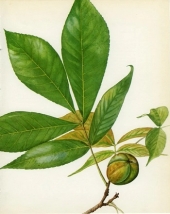Great question. I like your reasoning.
Keeping the long-term goal in sight, the focus should be upon building soil and building the fungal network throughout the soil profile. Healthy soil should take care of any fungal or bacterial problems. Basically, let your good microbes fight it out with any bad pathogens. If there is concern with bringing bad stuff onto your property via someone else's leaves, then
compost them for a few months. If you can heat the compost to 140 degrees, it will take care of most of your concerns. Whether those leaves be of the same species or something completely different, once the microbes get ahold of them, they'll be safe.
Keep your focus on the soil, not the trees. Build the soil and it'll take care of the trees. From that perspective, I wouldn't think that it makes much difference where the biomass comes from (from the same tree or from another) --- just add as much biomass as you can and keep as many living roots growing around the trees. The combination of carbon on top of the soil (mulch) and root exudates from plant roots (both your trees as well as other annual plants growing nearby) will keep the microbes happy.
Consider planting a diverse mix of cover crop seeds around the trees for the next couple of years. That will help feed the soil food web and build the kind of microbial community your trees will thrive on for years to come.
"The rule of no realm is mine. But all worthy things that are in peril as the world now stands, these are my care. And for my part, I shall not wholly fail in my task if anything that passes through this night can still grow fairer or bear fruit and flower again in days to come. For I too am a steward. Did you not know?" Gandolf














 1
1






